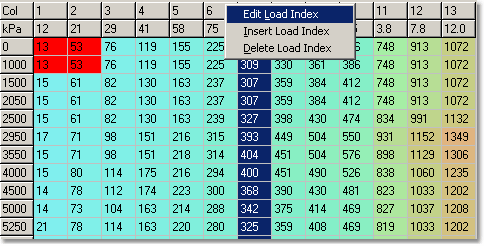The Load and Rpm indexes may be changed in the Table Window by right clicking on the load/rpm value.

Edit Index
This alters the current index. Note that the new index value must be between the values before and after it, so that the index values always ascend.

Insert Index
This inserts a new index at the current row or column. All other indexes and table values are moved downwards (rpm) or to the right (load). The last index is removed.
Delete Index
This deletes the current index. All other indexes and table values are moved upwards (rpm) or leftwards (load). A new index is added at the end of the table.
Notes:
| • | It is recommended, but not critical, to set the index values before any tuning is performed.. |
| • | Index values must always increase from the origin, but do not necessarily need to start at 0. |
| • | When the index for a table is altered, internally all tables using the same index must be updated. Thus for some calibrations it is not possible to alter the index values if every single instance of the index in use has not been identified. Load and rpm indexes may be shared between tables. Typically the fuel, ignition and knock tables share the same indexes, and the cam angle tables use their own indexes. Load indexes are shared between low and high speed cam tables of the same type, whereas rpm indexes are not shared between high and low speed cams. |
| • | When an index is changed the underlying tables are automatically compensated for the index change. Various algorithms are used to alter the affected table values. For edit and insert, interpolation is used to alter the table values for the index which has been edited/inserted. For delete, cells are shifted towards the deleted row/column, and an arbitrary new row or column is created at the end of the table. |